Exploring the Intricacies of Pyrite Cubes
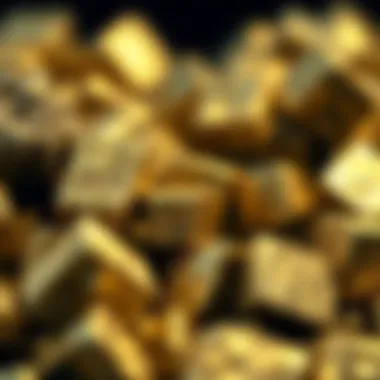
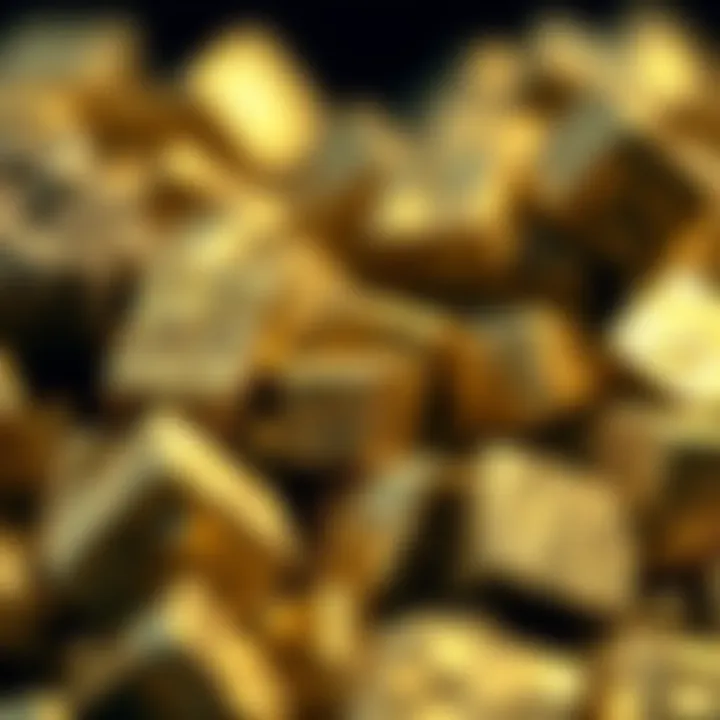
History and Origins
The world of pyrite cubes, often affectionately dubbed 'fool's gold', is as fascinating as it is complex. These distinctive minerals, with their shiny, metallic luster and enticing brass-yellow hue, have captured the interest of collectors and enthusiasts alike for centuries. The story of pyrite is not merely about geology; it intertwines beautifully with history, culture, and human curiosity.
Overview of Collectibles, Rocks, and Fossils
Throughout the ages, various minerals and fossils have been collected not just for their aesthetic appeal but also for their scientific significance. Pyrite, in particular, stands out due to its unique cubic formation and striking appearance. Collectors often seek gems and rocks that possess a story, a connection to the natural world that goes beyond mere visual attraction. Pyrite cubes have been a part of geological studies, art, and even folklore, making them a quintessential collectible in the realm of rocks and minerals.
Historical Significance and Cultural Impact
The historical narrative of pyrite is rich. In ancient Rome, it was used to start fires, and many cultures believed it to hold protective qualities. Notably, Native American tribes believed that the shimmering hues of pyrite could ward off negative energies. Its resemblance to gold led to misadventures in mining and trade, where miners would sometimes find themselves misled by its golden allure.
Cultural applications remain diverse:
- In gyms and workshops, pyrite was believed to enhance vitality.
- Artists famously harnessed the mineral's vibrant gold-like shine as a pigment in their creations.
- Today, pyrite's role extends into modern metaphysical practices, where it is seen as a symbol of wealth and abundance.
As we dive deeper into the subject, it becomes increasingly clear that pyrite cubes encapsulate stories of human ambition, misinterpretation, and creativity. They remind us of the intricate tapestry that links us to the earth and the ancient narratives that shape our collective understanding of minerals and their significance.
"Pyrite reflects our desire to uncover the secrets of the earth, and in its gleam, we find echoes of our own ambitions.”
Through its multifaceted history, fool's gold continues to inspire awe and respect, bridging the gap between nature and human culture. As we explore this captivating mineral further, we shall uncover not just its physical properties but also its lasting impact on art, history, and the scientific community.
Preamble to Pyrite Cubes
Understanding pyrite cubes is not just for geologists or avid collectors; it speaks to the very essence of our natural history and resource management. Pyrite, often referred to as 'fool's gold', captures the imagination with its glimmering appearance. As we delve into this topic, we uncover not only the mineral's beauty, but also its layered significance across cultural, historical, and industrial contexts. This article invites enthusiasts, collectors, and the curious alike to appreciate the multifaceted nature of pyrite cubes, revealing insights that go beyond their aesthetic appeal.
What is Pyrite?
Pyrite is a sulfide mineral with the chemical formula FeS₂, consisting of iron and sulfur. Its formation dates back millions of years, often occurring in sedimentary rocks or hydrothermal veins. While it's dubbed 'fool's gold' due to its striking resemblance to actual gold, pyrite has its own unique charm and importance.
The mineral has a shiny, yellowish-gold color and exhibits a metallic luster. Unlike gold, however, it is brittle and will break rather than deform under pressure. Pyrite is quite prevalent, found in various parts of the world, including Peru, Spain, and the United States, among others. It forms in a range of conditions, from low to high temperatures, making it a versatile subject for study and collection.
Distinctive Characteristics of Pyrite Cubes
Pyrite cubes possess distinctive characteristics that set them apart from other minerals.
- Crystal Structure: They commonly form in highly symmetrical cubic crystals. This geometry is a result of their internal atomic arrangement, which is quite pleasing to the eye, creating a tactile and visual allure that many collectors find irresistible.
- Color and Luster: The golden hue of pyrite varies based on purity and the presence of other minerals. Factors such as oxidation can cause color variations and affect the shine. The luster remains metallic and reflects light attractively, further enhancing its visual appeal.
- Hardness and Density: On the Mohs scale, pyrite ranks about 6 to 6.5, indicating it can scratch glass but is not as hard as quartz. Its density varies, affecting weight and feel for collectors, making some specimens more desirable than others.
"Collecting pyrite cubes is more than acquiring a mineral; it's about grasping the stories and the science behind its formation."
Understanding these characteristics is essential for collectors, not only to identify high-quality specimens but also to appreciate the mineral's journey from formation to your display shelf. This knowledge drives informed decisions in purchasing, caring for, and enjoying your pyrite collections.
Geological Formation of Pyrite
Understanding the geological formation of pyrite is essential for grasping its role in the Earth’s mineral composition and the broader geological processes. Pyrite, often dubbed fool's gold for its alluring metallic sheen, is not just an aesthetic mineral; its formation tells a story of the conditions under which it forms. Knowing this aspect enriches the appreciation for collectors and provides insights into the global geological history.
Chemical Composition of Pyrite
At the core of pyrite’s identity lies its chemical makeup, which is FeS₂ (iron disulfide). This simple formula is indeed quite telling.
- Iron (Fe): An essential element found abundantly in Earth’s crust, it provides strength and stability.
- Sulfur (S): This element is less common and often contrasts with iron in the natural world.
When iron and sulfur combine under the right conditions, they crystallize into the cubic structure that we associate with pyrite. This specific formation is crucial because it embodies a balance between the two elements in a way that produces not only the distinctive color but also contributes to the mineral's properties that make it a point of curiosity among collectors.
"Pyrite's crystalline allure belies its complexity, mirroring the intricate relationships within our planet’s crust."
This chemical composition does more than just define pyrite; it influences its properties such as hardness, density, and even its behavior during mining. Recognizing these properties enables collectors to appreciate what sets quality specimens apart, fostering a deeper connection with each piece they encounter.
Formation Environments
The environments in which pyrite forms can vary dramatically, influencing its morphology and occurrences. Pyrite can be found in several geological settings:
- Igneous Rocks: Located within some crystalline mainlands, pyrite often forms from the cooling of magma.
- Sedimentary Rocks: In sedimentary basins, pyrite can precipitate from marine or lacustrine environments, often in association with organic matter.
- Metamorphic Settings: During the metamorphosis of certain rock types, pyrite can crystallize under heat and pressure, showcasing its adaptability.
These formation environments contribute to the diversity seen in pyrite specimens. For example, those formed in sedimentary contexts may display a different surface finish compared to their igneous counterparts. This divergence in environments creates a treasure trove for collectors, who often seek out pyrite with unique characteristics stemming from its geological history.
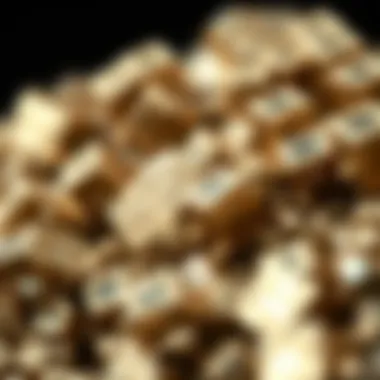
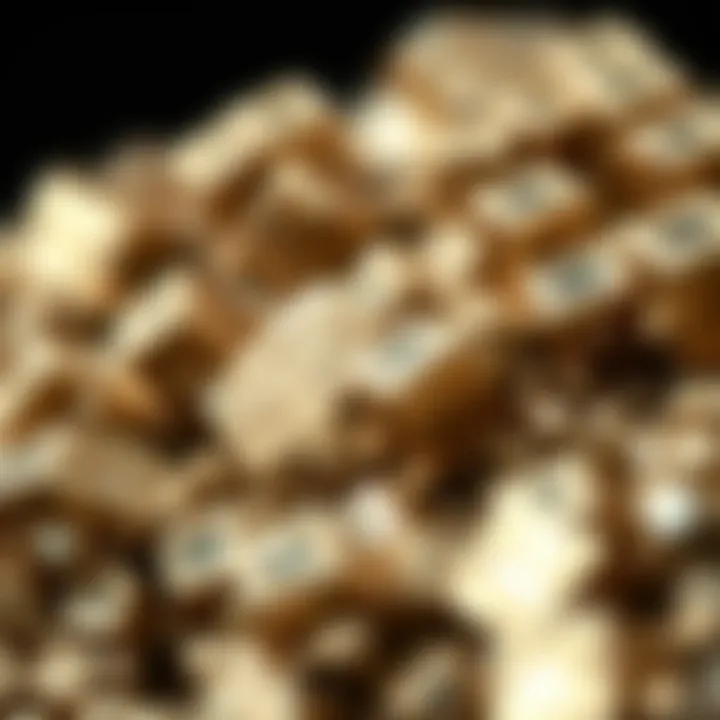
In summary, the geological formation of pyrite is not just about its physical presence; it echoes the ancient processes that shaped our planet. By understanding how pyrite forms and the conditions that support its crystallization, collectors can appreciate their specimens not just as mere objects, but as fragments of a much larger and fascinating geological narrative.
Physical Properties of Pyrite
The physical properties of pyrite are fundamental in understanding its unique appeal and significance in various fields. As a mineral that often bears the title of "fool's gold," it carries both geological and aesthetic charms that endear it to collectors, artists, and scientists alike. This section will focus on two crucial aspects: the crystal structure and the luster and color variations of pyrite, providing insights that enhance our appreciation of this intriguing mineral.
Crystal Structure
Pyrite's crystal structure is cubic, which contributes significantly to its distinctive appearance. The mineral is classified within the isometric crystal system, characterized by its symmetrical and well-defined cubic shapes. Each pyrite cube boasts sharp edges and faces, presenting a gleaming metallic surface that catches the eye. This crystallographic characteristic not only makes pyrite aesthetically pleasing but also plays a role in its durability and physical resistance.
Understanding the crystal lattice of pyrite reveals much about how this mineral forms and behaves. Pyrite consists of iron and sulfur, and its structure is arranged in such a way that every sulfur atom is surrounded by four iron atoms in a tetrahedral configuration. This orderly arrangement not only contributes to its hardness—ranking about 6 to 6.5 on the Mohs scale—but also impacts its interaction with light, ultimately lending pyrite its captivating luster.
Moreover, the symmetrical nature of the crystal helps in distinguishing high-quality specimens from those of lesser quality. Collectors often seek out well-formed pyrite cubes, recognizing that the precision of their structure is a testament to both the conditions under which they formed and their potential value.
"The geometric precision of a pyrite cube reflects the forces of nature that shaped it, reminding us that beauty often lies within a mathematical order."
Luster and Color Variations
The luster of pyrite is one of its most defining attributes, registering as metallic to sub-metallic. This shiny surface is what leads many to mistakenly identify it as gold at first glance. The golden-brass color, which can sometimes have a pale yellow or even a greenish tint—specifically in weathered specimens—adds to its allure. Given its robust nature, pyrite can withstand various environments, which allows for a range of appearances depending on external conditions.
When discussing color variations, it’s crucial to note that the presence of various impurities and minerals can alter the traditional yellow hue. Some pyrite cubes may display different shadings due to oxidation, leading to hues of brown or even gray. Thus, these variations make each piece unique and can significantly influence its desirability in the collecting community.
In the realm of aesthetics, the interplay between the bright luster and color variations is delightfully framed by the textured surface of the crystal faces. Because light interacts differently with facets, a pyrite cube can appear to shimmer or change its appearance, especially when viewed from diverse angles, enhancing its status as a coveted collectible.
In short, the physical properties of pyrite—specifically its crystal structure and luster with color variations—offer insights that reach well beyond mere appearances. They highlight the mineral's formation processes, its geological significance, and additionally, its aesthetic and economic value in today's market.
For more in-depth knowledge, you can refer to resources like Britannica or explore collector forums such as reddit.com.
Historical Significance of Pyrite
The historical significance of pyrite is more intricate than many realize. This shiny, brass-colored mineral has painted a colorful picture across various cultures and periods. It's not just a pretty decoration or a collectible; it represents human curiosity, beliefs, and the evolution of our understanding of natural resources. Pyrite's journey through history intertwines with socio-cultural dynamics and economic factors that shaped societies.
Cultural Uses through the Ages
Throughout history, pyrite has been used in various ways that go beyond mere ornamentation. Ancient civilizations, like the Inca and Aztecs, valued it for its luster and believed it held spiritual significance. They often crafted it into ceremonial items. For instance, pyrite mirrors were used for scrying or divination. The reflective surface of these stones allowed shamans and priests to glimpse into the future or receive messages from the spiritual realm. This showcases how pyrite wasn't merely seen as a shiny object but a conduit for mysticism.
In more practical applications, during the Middle Ages, it had practical value as a source of sparks for fire-making, placed alongside steel or flint. This gave it a critical role in everyday survival, seen as an important tool for igniting fires to cook food and provide warmth.
In the 19th century, amidst the gold rushes, the allure of pyrite shifted once again. It became synonymous with hope and disappointment as many prospectors mistook it for gold. This led to the term "Fool's Gold," which conveys a larger narrative about ambition and the sometimes deceptive nature of appearances. Even today, in art, pyrite continues to captivate artists and mineral enthusiasts with its aesthetic wonders, symbolizing both nature's formidable beauty and the mistakes of eagerness.
Misconceptions about 'Fool's Gold'
The colloquial term 'Fool's Gold' epitomizes how misconceptions about pyrite affect its reputation. Many people initially believe that pyrite is just worthless rock, without value or purpose because it resembles gold. This misapprehension overlooks its various attributes and importance. As a mineral, pyrite has significant applications, especially in the industrial sector, where it is mined for sulfur and iron.
Moreover, the term can discourage collectors and enthusiasts from appreciating pyrite's unique qualities. Rather than dismissing it, collectors should recognize its history and the lessons it imparts about human oversight and the quest for wealth. Unlike real gold, which serves as a currency and has intrinsic value due to its rarity, pyrite highlights the nuances of value in nature and society. This distinction is vital for understanding the role of minerals in both culture and economy.
In summary, the story of pyrite is rich and layered. Its historical significance is not just academic; it's woven into the fabric of human experience. As collectors and enthusiasts delve into the world of pyrite, they unveil not just a mineral but a narrative that reflects our intertwined history with the earth.
Applications of Pyrite in Various Fields
The applications of pyrite extend far beyond its superficial resemblance to gold, making it a multifaceted mineral of great interest. In this section, we will explore how pyrite is not only a sought-after collectible for enthusiasts but also a valuable resource in various industries. By unpicking the significance of pyrite's applications, we find it plays a pivotal role in both industrial processes and cultural expression.
Industrial Uses of Pyrite
Pyrite's industrial significance cannot be overstated. Historically, its sulfur content has been harnessed in multiple chemical processes, leading to its utilization in various industries. Here are some prevalent industrial applications:
- Sulfur Production: One of the primary uses of pyrite is in the manufacturing of sulfur dioxide, which is essential for producing sulfuric acid. Sulfuric acid's role in batteries, fertilizers, and chemical synthesis highlights how pyrite contributes significantly to modern commerce.
- Catalyst in Chemical Reactions: In certain chemical processes, pyrite can serve as a catalyst, facilitating reactions without altering its own composition. This property is particularly advantageous in the production of biodiesel, showcasing pyrite's role in advancing sustainable energy.
- Mining and Metallurgy: Pyrite is often associated with valuable ores, particularly copper and gold. In mining operations, its presence can indicate rich veins of other minerals, thus aiding in the targeting of extraction projects.
- Fireworks and Explosives: The explosive potential of pyrite when heated can be harnessed in certain types of fireworks and explosives. While not the primary component, its contribution cannot be overlooked in the realm of pyrotechnics.
Furthermore, because of the significance of pyrite resources, understanding sustainable mining practices becomes critical for reducing environmental impacts. Efficient use of pyrite contributes to the overall reduction of waste associated with mining operations.
Pyrite in Art and Decor
Beyond its industrial applications, pyrite's visual appeal means it finds numerous roles in art and decorative practices. Its shimmering surface and distinctive cubic formations offer an aesthetic quality that captivates artists and designers alike. Here are some ways pyrite has entered the artistic realm:
- Jewelry Making: Artisans frequently incorporate pyrite into jewelry designs for its stunning appearance. Pendants, earrings, and bracelets adorned with pyrite give a unique touch that blends elegance with a raw, natural feel.
- Interior Decor: In interior design, pyrite's metallic luster complements various styles, from rustic to modern. Large specimens can serve as striking conversation pieces on coffee tables or as natural sculptures.
- Sculpture and Mixed Media: Artists often use pyrite in mixed media installations, appreciating its texture and reflective qualities. Some contemporary sculptors are integrating pyrite into their work to symbolize themes of transformation.
- Educational Uses: In educational settings, pieces of pyrite are employed to teach about mineralogy and geology. Their unique characteristics make them ideal specimens for demonstrations and discussions about natural resources and environmental science.
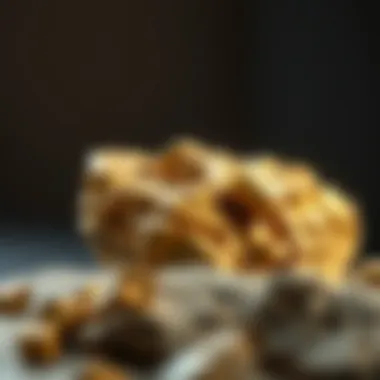
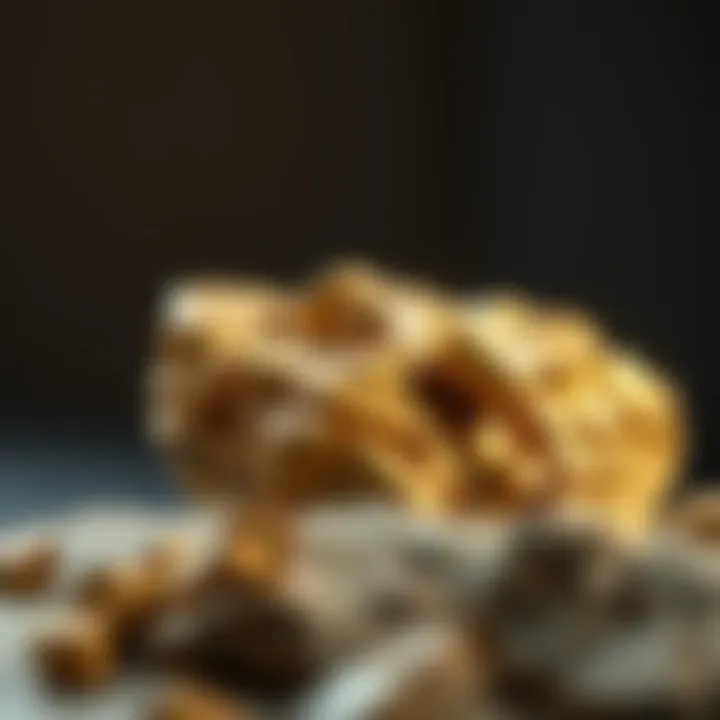
Pyrite embodies both a historical narrative of exploitation and a modern reclamation of artistic value. Its dual identity reflects the complexities of mineral use in our society.
Engaging with pyrite—whether in industrial applications or artistic endeavors—highlights its multifaceted nature. Understanding these dimensions not only enhances our appreciation of the mineral but also informs the responsible practices that ensure its continued relevance and sustainability.
Collecting Pyrite Cubes
Collecting pyrite cubes is not just a hobby but also an engaging exploration into the rich world of geology and mineralogy. For enthusiasts and dedicated collectors alike, each pyrite specimen tells a story that transcends its glimmering appearance. Understanding the significance of these cubes—often dubbed 'fool's gold'—extends beyond mere collecting; it fosters a connection to the Earth's history and natural beauty.
When gathering pyrite cubes, one must consider various factors that contribute to the allure and integrity of each specimen. Quality, provenance, and aesthetic aspects all play pivotal roles in shaping a collector's experience. Pyrite, with its metallic luster and unique crystal habits, attracts those captivated by both its visual appeal and underlying geological narrative.
Identifying Quality Specimens
Identifying quality pyrite specimens is an art that requires a keen eye and often years of practice. First and foremost, a collector should be on the lookout for well-formed cubes and octahedra—pyrite’s hallmark shapes. These geometrically perfect crystals are not just striking to behold; they also indicate that the mineral formed in an environment favorable to crystal growth.
Next, the surface luster is paramount; a bright, highly reflective surface generally signifies a high-quality sample. However, imperfections like scratches or dull areas can diminish value. When inspecting, assess:
- Crystal form: Look for sharp edges
- Luster: It should shine like polished gold
- Clarity: The purity of color, with fewer impurities enhancing its desirability
To better discern good specimens from mediocre ones, attend mineral shows or visit reputable dealers who specialize in pyrite. Engaging in discussions with other collectors can also sharpen your skills in identification.
Valuation of Pyrite Cubes
Valuing pyrite cubes can feel as complex as appraising fine art. Prices for specimens can fluctuate based on several factors. For example, a small cubic crystal from a famous locality often commands a higher price compared to a larger piece with less history.
Here are some factors to consider:
- Size and weight: Larger crystals can be rarer but not always more valuable
- Locality: Some regions are famed for producing exceptional pyrite, which can elevate the price
- Clarity and luster: As previously stated, a bright and flawless surface often results in a higher appraisal
- Uniqueness: Unusual formations or inclusions may warrant a premium
Most importantly, staying informed about market trends will help set reasonable expectations. Online auction sites and mineral fairs serve as valuable resources to gauge current valuations.
Engaging with community forums on platforms like Reddit can provide insights into specific transactions, helping both novice and seasoned collectors navigate the fluctuating market.
"Knowing the stories behind your pyrite cubes enriches their value, both materially and sentimentally."
In sum, whether you are identifying or valuing pyrite cubes, each step enhances your appreciation for this captivating mineral. As collectors, it’s essential to engage actively with the community and continuously educate oneself on the nuances that make pyrite such a remarkable subject of fascination.
Caring for Pyrite Cubes
Caring for pyrite cubes is an essential aspect that goes beyond mere aesthetics. These striking minerals, often mistaken for gold, deserve attention and proper handling to ensure their longevity and visual appeal. By maintaining their condition, collectors not only protect their investments but also preserve the stories and history embedded within these fascinating specimens.
Cleaning Techniques
Cleaning pyrite cubes requires a gentle touch. While they are relatively sturdy, improper cleaning methods can leave scratches or diminish their shine. Here’s an approach that blends effectiveness with care:
- Initial Inspection: Before diving into cleaning, inspect the cube closely. Check for cracks or fragile areas. A gentle hand goes a long way.
- Dry Method: For light dust or surface dirt, a soft brush (like a makeup brush) is often sufficient. Flick away dust without applying pressure.
- Wet Method: For stubborn grime, a mild soap solution works wonders. Mix a few drops of dish soap in warm water. Dip a soft cloth and lightly wipe the surface. Rinse with clean water and dry with another soft cloth, avoiding direct sunlight.
- Avoid Abrasives: Steer clear of anything that could scratch or damage the surface. No harsh chemicals or abrasive materials!
Remember, the goal is to maintain the intrinsic beauty of these cubes while treating them with the respect they deserve.
Display and Storage Recommendations
When it comes to displaying and storing pyrite cubes, the right approach can elevate their beauty while ensuring their safety. Here are some considerations:
- Display Cases: Opt for display cases that offer both aesthetic appeal and protection. Glass display cases are ideal, allowing light to dance off the cubes without exposing them to dust and potential damage.
- Avoid Direct Sunlight: While pyrite's luster is captivating, prolonged exposure to sunlight can fade its vibrant color over time. Place your specimens in a shaded area to maintain their brilliance.
- Stable Environment: Consider the humidity and temperature of the display space. Pyrite can tarnish if exposed to excessive moisture. A cool, dry environment is preferred.
- Secure Storage: When not on display, store pyrite cubes in individual cotton bags or soft cloths to prevent scratching against other minerals. Boxes lined with soft materials can also provide adequate protection.
"Proper care today ensures the beauty of tomorrow's treasures."
By following these cleaning and storage practices, collectors will not only enhance the visibility of their pyrite cubes but also safeguard their investments, enriching their collections for years to come. Maintaining a thoughtful approach to care is pivotal for both aesthetic pleasure and relational history with these stunning mineral cubes.
For more insights into mineral care, consider checking websites like Rocks and Minerals and Mindat for further information on proper mineral care strategies.
The Impact of Mining on Pyrite Resources
Mining of pyrite, while integral for acquiring this unique mineral, possesses layers of complexities that must be addressed. Firstly, pyrite bears significance not just in geology but also in numerous industries, including construction and metallurgy. It is of utmost importance to comprehend the implications of mining, its benefits, and the pressing concerns that accompany it. This section aims to shed light on sustainable approaches and environmental impacts that go hand-in-hand with the extraction of pyrite, ensuring we understand its place in both industry and ecology.
Sustainable Practices in Pyrite Mining
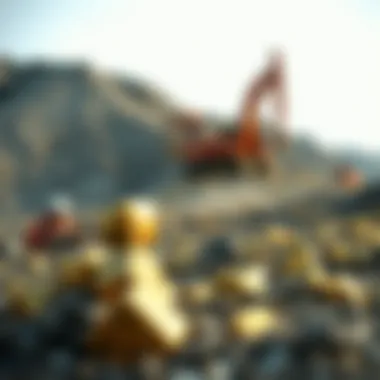
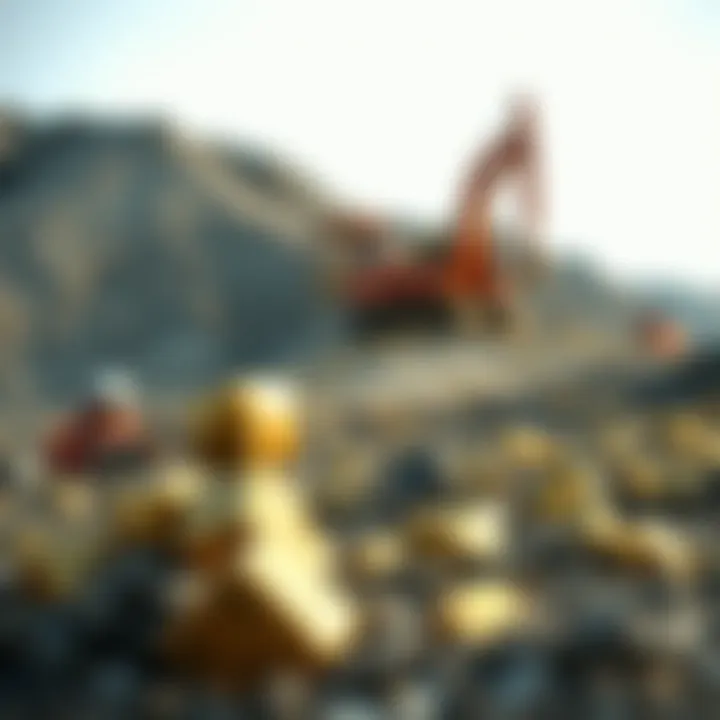
The quest for sustainability in pyrite mining leads us to consider practices that aim to minimize ecological footprints. Mining operations, at their core, can disrupt ecosystems, degrade the land, and pollute water sources. However, contemporary practices have begun to pivot towards methods that are less harmful.
- Reclamation Initiatives: Sites can often be restored post-mining. This involves replanting vegetation, managing the local water supply, and restoring habitats.
- Precision Mining Technology: Adopting advanced technologies improves the precision of extraction. This approach reduces the amount of waste generated and diminishes landscape disruption.
- Community Engagement: Involving local communities in decision-making processes fosters a sense of ownership and responsibility, leading to more sustainable operations.
Efforts to promote these practices are more than just compliance; they reflect a shift towards a more conscientious mining culture that prioritizes the environment and society alongside economic gain. The adoption of such practices must remain a continuous effort, ensuring that future generations inherit a viable planet.
Environmental Considerations
The environmental considerations surrounding pyrite mining are diverse and multifaceted.
One of the primary concerns is acid mine drainage, which occurs when sulfide minerals like pyrite are exposed to oxygen and water, leading to the formation of sulfuric acid. This can have dire consequences for local waterways, harming aquatic life and making water undrinkable.
"If the land suffers, we all suffer eventually."
Moreover, there are also issues regarding deforestation and the loss of biodiversity. When forests are cleared to make room for mining operations, the local fauna and flora can be severely impacted. A few of the environmental impacts include:
- Water Contamination: Leachates from mining operations can poison rivers and streams, affecting wildlife and human communities.
- Soil Erosion: Removal of vegetation leads to soil erosion, which may create landslides and disrupt local agriculture.
- Air Quality: Dust and emissions from machinery can degrade air quality, posing health risks for miners and nearby populations.
While advocates for the pyrite mining industry focus on economic benefits, it is vital to balance these with a robust environmental ethos. This can ensure the ongoing viability and appeal of pyrite not just as a resource, but as a valued component of our planet's natural heritage.
In summary, addressing these elements calls for a collective effort to create a mining culture that recognizes both the intrinsic value of pyrite and the critical need to operate sustainably. As collectors and enthusiasts of pyrite cubes, understanding these intricacies equips us with a more profound respect for the mineral and its journey from the earth to our display cabinets.
Community Engagement and Knowledge Sharing
Engagement within the community around pyrite cubes fosters a deeper understanding and appreciation for this unique mineral. Knowledge sharing plays a crucial role not only in promoting awareness but also in preserving the culture of mineral collecting. Connecting enthusiasts, collectors, and educators develops a network where experiences can be exchanged, and insights on pyrite's various aspects can be shared.
The benefits of such engagement are abundant. For one, it encourages collectors to share their unique finds and experiences. They might swap tips on how to identify quality specimens or share cleaning techniques that preserve pyrite's natural luster. Additionally, community events can offer opportunities for learning through workshops, talks, and exhibitions, allowing both novice and experienced collectors to benefit.
A thoughtful approach ensures these initiatives nurture interest while respecting the mineral's heritage. It is vital to emphasize sustainable practices in both mining and collecting, teaching collectors the importance of sourcing specimens ethically.
"Community is much like a mineral collection. Each piece adds value to the whole, creating a rich tapestry of knowledge and experience."
Initiatives for Collectors
Several initiatives can be adopted to enhance community engagement among pyrite collectors. Local clubs or online forums can create spaces where individuals come together to discuss their passions. For example, collectors could organize field trips to active mining locations, allowing members to see the processes involved in obtaining pyrite while unearthing their treasures.
Workshops can also focus on specific skills or topics like preservation techniques, mineral identification, or geological concepts related to pyrite. By hosting expert speakers, clubs can illuminate facets of pyrite history, enriching collectors' understanding beyond mere ownership.
Moreover, social media can be a beneficial tool to foster connections among enthusiasts. Platforms such as Facebook or Reddit can host groups specifically dedicated to pyrite, where members can share photographs, stories, and updates on new finds, thus keeping the community lively and informed.
FossiBelle's Role in Mineral Education
FossiBelle plays an instrumental role in mineral education, especially concerning pyrite cubes. By providing resources tailored to collectors and enthusiasts, FossiBelle ensures that knowledge is accessible to all levels of expertise. This includes detailed articles that break down the complexities of pyrite, making it easier to grasp for beginners while still appealing to seasoned collectors.
The organization can host events that encourage hands-on learning, such as guided tours through mineral-rich areas or educational seminars led by knowledgeable geologists. Through these initiatives, FossiBelle encourages responsible collecting and highlights the scientific significance of pyrite.
Furthermore, they can partner with schools and universities, rolling out programs that bring the science of minerals into the education system. This approach not only sparks interest among younger generations but also cultivates a future community of passionate collectors and geologists.
In essence, FossiBelle embodies the heart of mineral education by intertwining knowledge sharing with community involvement, striving to elevate the discourse around pyrite and its many dimensions.
Ending
The conclusion ties together the intricate threads woven throughout the article about pyrite cubes, illustrating their multifaceted nature and significance. This section emphasizes the value of understanding pyrite beyond its superficial appeal as a shiny mineral. Rather, it beckons to collectors and enthusiasts alike to appreciate deeper elements like its geological story, cultural significance, and the environmental challenges associated with its mining.
Reflections on Pyrite's Value
Pyrite, often termed 'fool's gold', offers more than just an aesthetically pleasing appearance. Collectors must consider its historical context. For centuries, various cultures have attributed different meanings to pyrite. For instance, the ancient Incas utilized it for ceremonial practices while European alchemists saw it as a building block for wealth. Reflective of human nature, this mineral demonstrates our enduring quest for beauty and value. Moreover, contemporary collectors add to the narrative by finding not just satisfaction in possession but also a responsibility towards sustainable practices. Collecting is thus repositioned from mere acquisition to stewardship—a passionate engagement with nature's gifts.
Looking Ahead: The Future of Pyrite Collecting
In looking to the future, the realm of pyrite collecting is evolving. The expanding interest in sustainability and eco-considerations makes it imperative for collectors to engage with ethical sourcing. Organizations like FossiBelle encourage engagement through community initiatives, promoting awareness and education.
With advances in mineralogy and technology, there’s also the potential for innovative ways to display and utilize these minerals. For example, integrating pyrite cubes into modern decor or art pieces is becoming fashionable, showcasing their versatility. Moreover, as educational programs flourish, illuminating the scientific properties of pyrite and the effects of mining, collectors might find themselves in a unique position of influence—acting as ambassadors for responsible collecting.
Thus, as we navigate the landscape of pyrite cubes, its future glimmers with promise, bound not just by its intrinsic beauty but also by the intention to enhance our collective knowledge and responsibility toward Earth’s treasures.
"Collecting is not just about possession; it is about understanding and preserving the stories and gifts from our planet."
For those seeking to dive deeper into the world of pyrite, there are valuable resources available:



